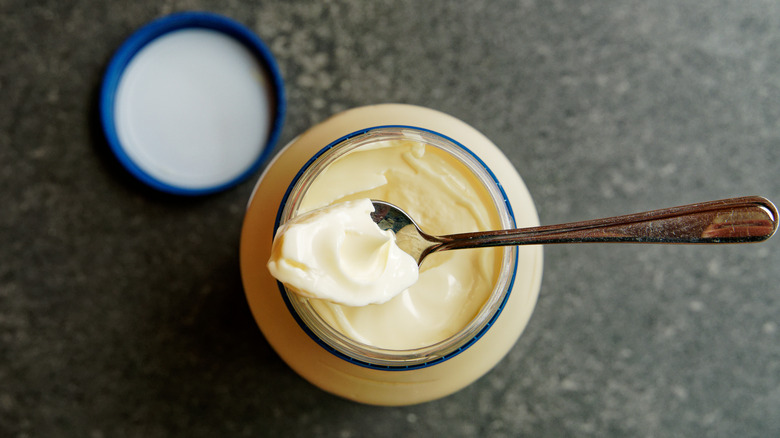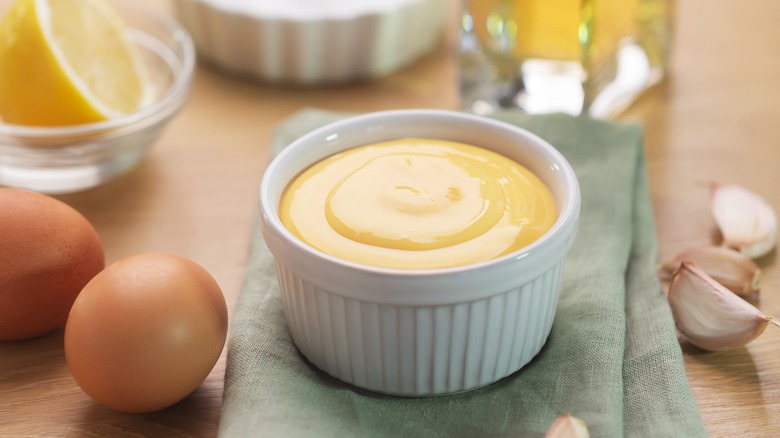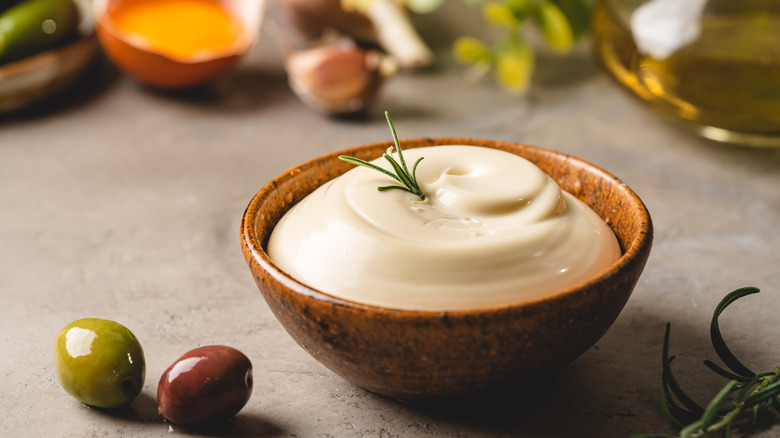What's The Difference Between Mayo And Aioli?
Creamy, smooth, and a little tangy, aioli and mayonnaise are commonly likened to equivalents in their condiment nature. You may even hear in some circles: Isn't aioli just a garlic mayonnaise? It's easy to make this observation; after all, they are both creamy emulsions with a yellowy-tinted color. However, it's naive to assume their origins, creation, and taste are one and the same. Beneath those smooth layers are many differences not visible to the naked eye.
One of the most obvious is in the primary flavor. While mayonnaise is prized for that mild, eggy savoriness, aioli is all about the tangy, pungent taste of garlic. This might not be news to you as aioli is starting to creep into well-known brands and as a popular dip in restaurants. While the unexpected mayonnaise, once regarded as a luxury food, has evolved into an everyday household condiment, aioli was surprisingly around long before mayo's history even began. That's right — aioli predates mayonnaise. These differences represent just the surface layer of what is hiding beneath these creamy sauces, and it's time to delve deeper.
A difference in history
Aioli, also written as aïoli, alhòli, or aiòli, translates to garlic oil in Catalonia. There are various claims of its birthright, where some believe it was a traditional lenten dish (a dish consumed during Lent) in Provence, France. Yet others claim its heritage can be traced to the period of Roman rule in Tarragona, a city in the south of Catalonia – now a recognized region in Spain. While it may remain a mystery who first mixed aioli, its origins are essentially tied to the creation of olive oil in the Mediterranean. Without olive oil, no aioli.
On the other hand, the heated origins of mayonnaise are much more recent. While its birth is somewhat contested between France and Spain, an early version of the condiment was recorded by French commander Duke de Richelieu, who is believed to have first tried the sauce after laying siege to the now-Spanish island of Minorca (now Menorca) in 1756. While its divided heritage leaves its true beginnings clouded, one thing is sure: It came after aioli.
Although one interesting parallel to note is that similar to the way that "aioli ” denotes garlic and oil, the root of the word mayonnaise is believed to have evolved from the old French words moyeunaise, moyeu, which means egg yolk. Despite their different histories, both names remain rooted in the primary ingredients they contain.
Is it the mayo or aioli you're looking for?
Traditionally, aioli is made from a mixture of olive oil and garlic. The two are pounded in a pestle and mortar until an emulsion is created; this allows the two ingredients to bind without compromising on flavor. The flavor of pungent garlic and rich olive oil sets this condiment apart from mayonnaise's mild and soothing taste.
In contrast, mayonnaise is made by vigorously emulsifying a mixture of beaten egg yolks, canola oil, lemon juice or vinegar, mustard, and salt. Unlike aioli, which requires mashing to ensure the garlic blends into the olive oil, to emulsify the ingredients in mayonnaise, you need to be able to combine and whisk. It's important to note that canola oil has a neutral flavor compared to olive oil, which is more complex and unravels the taste it's paired with.
While the first recipes for aioli did not use egg yolks, it is now a common addition, alongside a little lemon and bread, to intensify the creaminess. With these included, the sauce becomes smoother and less fiery. A modern aioli is more similar to mayonnaise than its traditional version; however, its garlic tang keeps it divided. Aioli traditionalists may even go as far as to state that any egg yolks added to aioli immediately transform the sauce into a mayonnaise. While debates regarding added ingredients may persist, hopefully, you will now better understand the differences between mayonnaise and aioli.


